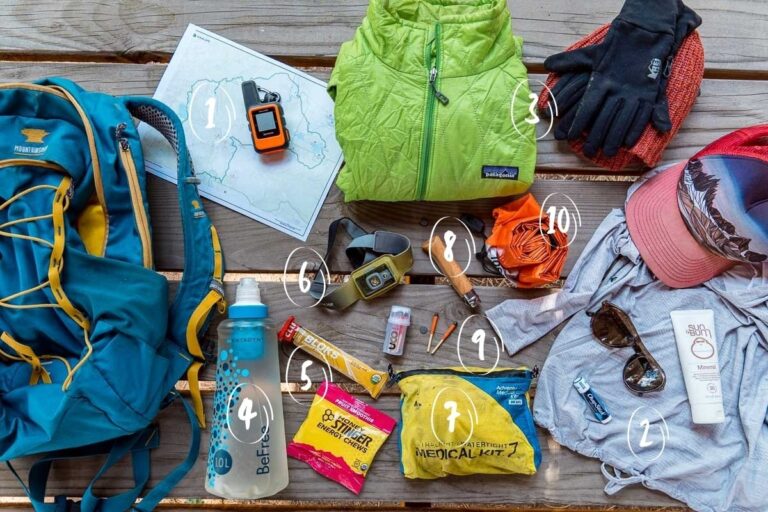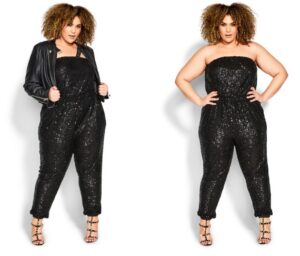Wear lightweight, moisture-wicking clothing and shoes with good grip when hiking in summer. As temperatures rise and daylight extends, many people take advantage of the opportunity to explore the great outdoors by going hiking.
In order to make the most of those voyages, it’s critical to have the appropriate clothing and equipment. Hiking clothing must strike a delicate balance between protection from the elements and comfort under the sweltering sun. Select lightweight clothing, easy to wear, and made of moisture-wicking materials that are breathable enough to keep you comfortable even when you’re sweating heavily.
Always wear shoes that provide excellent traction and ankle support; sneakers, running shoes, or hiking boots are all appropriate options. In this article, we’ll go into more detail on what to wear when hiking in the summertime, including everything from headwear to footwear.

Credit: www.moonhoneytravel.com
Dress For Success: Planning Your Hiking Outfit
Hiking in the summer is always a great way to enjoy nature and stay active. Whether you’re hiking for an hour or a full day, it is important to dress appropriately. Here are some important tips to consider before hitting the trails.
Choose Lightweight And Breathable Fabrics To Prevent Overheating
When it comes to selecting hiking clothes, it’s crucial to choose fabrics that are lightweight and breathable. The goal is to keep your body cool and dry, which will help you feel comfortable throughout your hike. Here are some fabrics to consider:
- Nylon: It’s a lightweight and quick-drying fabric that is perfect for hiking in hot weather.
- Polyester: It’s a breathable, moisture-wicking, and quick-drying fabric that is ideal for summer hiking.
- Merino wool: This fabric is lightweight, moisture-wicking, and keeps you cool in hot weather.
Protect Your Skin With Upf-Rated Clothing
Summer hiking means exposure to the sun, which can be damaging to your skin. Protect your skin by wearing clothes with upf ratings. Upf stands for ultraviolet protection factor, and it measures how effectively a fabric blocks uv rays. Here’s what to consider:
- Upf 20-24: Good protection for everyday wear.
- Upf 25-39: Very good protection that is great for extended outdoor activity.
- Upf 40-50+: Excellent protection that is ideal for the brightest and hottest days.
Footwear: What To Wear For Hiking In The Summer
Wearing the right footwear is critical to an enjoyable hiking experience. Here are some things to think about:
- Breathability: Look for shoes that allow your feet to breathe, like sandals or lightweight hiking shoes.
- Traction: Choose footwear with good traction for uneven terrain, like hiking boots or trail runners.
- Comfort: Make sure your shoes fit well and have enough support.
Accessories Matter Too!
Don’t overlook accessories when preparing your hiking outfit. Here are some that could come in handy:
- Hat: A hat will protect your face and neck from the sun.
- Sunglasses: Protect your eyes from harmful uv rays and glare.
- Backpack: A backpack will help you carry water, snacks, and extra clothes.
By following these guidelines, you’ll be prepared for a comfortable and safe hiking experience this summer. Remember to have fun while exploring nature responsibly and leave no trace behind.
Stay Safe And Comfortable: The Importance Of Layering
Getting dressed for a hiking trip can be a daunting task, but there are ways to make it easier. One of the most important means of ensuring comfort on a hike is layering. Layering helps you prepare for sudden weather changes, which can happen even in the summer, and enables you to stay both safe and comfortable.
Here are the essential layers you should consider when preparing to go on a hike.
Base Layer: Wicking Fabric That Draws Sweat Away From Your Body
The base layer is the closest layer to your skin and is designed to wick moisture away from your body. Your base layer should be made of high-quality technical fabric, such as polyester or merino wool.
- Wearing a technical base layer provides you with an additional layer that can help to manage sweat and moisture, keeping you dry and comfortable throughout your hike.
- Look for breathable, lightweight, and moisture-wicking fabric to keep you dry.
Mid Layer: Provides Insulation And Helps Regulate Body Temperature
The mid layer is your insulation layer and helps regulate your body temperature. It traps warm air close to your body, keeping you warm in cooler temperatures.
- Fleece is a popular choice as it’s lightweight and dries quickly.
- Wool is also a good option as it wicks moisture away from your body.
Outer Layer: Should Be Waterproof And Windproof
The outer layer should be waterproof and windproof, protecting you from rain and wind. Look for a jacket or shell that is made from gore-tex or other waterproof-breathable fabric.
- Ensure that the outer layer is large enough to allow for layers underneath without being too constrictive around the shoulders and chest.
- When choosing an outer layer, consider its weight, volume, and packability.
Layering Tips To Help You Prepare For Sudden Weather Changes
- Consider the weather in the area where you will be hiking and plan accordingly.
- Always carry an extra layer with you in your backpack, even if the weather forecast predicts sunshine.
- Dress in layers that can be easily removed and stored away as needed.
- Wear comfortable, moisture-wicking socks that will protect your feet and keep them dry.
- Choose clothes that offer uv protection and help to prevent sunburns.
- Remember to hydrate before and during your hike as water helps to regulate your body temperature.
Layering is essential when hiking, no matter the season. By following the tips above, you can prepare yourself for sudden weather changes and ensure that you are both safe and comfortable on your hike. So, don’t forget to layer up!
Understanding Your Environment: Clothes For Hiking In Different Climates
When it comes to hiking, the clothes you wear play a crucial role in your overall experience. Wearing the proper attire will help keep you comfortable and protected, regardless of the climate you’re hiking in. Below, we’ll discuss what to wear when hiking in different climates.
Tips For Hiking In A Hot Climate
Hiking in hot weather can be challenging, especially if you’re not used to it. To stay comfortable and safe, consider the following tips:
- Wear light-colored clothing made of breathable fabrics to keep cool.
- Opt for long-sleeved shirts and pants to protect your skin from the sun.
- Wear a hat to shield your head and face from the sun.
- Choose hiking socks made of moisture-wicking materials to help keep your feet dry.
- Don’t forget to apply sunscreen regularly to protect your skin from harmful uv rays.
Hiking In A Humid Climate
Humidity can make hiking feel much more strenuous than it actually is. To help combat this, keep the following tips in mind:
- Wear lightweight, breathable clothing to stay cool.
- Choose fabrics that wick moisture away from your body, such as merino wool or synthetic blends.
- Opt for loose-fitting clothing to allow for better air circulation.
- Wear a hat to protect your head and face from the sun.
- Consider carrying a small towel to wipe away sweat and moisture.
Clothes To Wear For Hiking In The Mountains
Hiking in the mountains can present a range of weather conditions, so it’s essential to come prepared. Here is what you need to consider when dressing for a mountain hike:
- Dress in layers to accommodate for temperature changes.
- Consider wearing a base layer made of moisture-wicking material, such as wool or synthetic blends.
- Opt for a mid-layer made of fleece or other insulating materials to keep warm.
- Wear a waterproof and windproof jacket as an outer layer to protect against rain and wind.
- Wear sturdy hiking boots with good ankle support to help prevent injury.
- Don’t forget to wear a hat and gloves to protect your head, face, and hands from the sun and wind.
By keeping these tips in mind, you’ll be able to dress appropriately for any hiking climate. Remember, hiking is a fun and rewarding activity, so be sure to dress accordingly and enjoy your experience!
Preparing For Your Hike: Packing Essentials
When it comes to hiking in the summer, preparation is key. Knowing what to wear and pack can make all the difference in your level of comfort and safety during your hike. Keep these essentials in mind when packing for your hike.
Making A List Of Everything You Need
To ensure you have everything you need for your hike, make a comprehensive list of items that you will require. Here are some of the essentials to consider:
- A map and compass (or gps) with extra batteries
- A first-aid kit, including insect repellent, sunscreen, and medications
- A multi-purpose tool, such as a swiss army knife
- Adequate water (at least two liters per person)
- High-energy snacks, such as trail mix, energy bars, or jerky
- A whistle, to signal for help if necessary
- Sunglasses and a hat to protect you from the sun
- A headlamp or flashlight with extra batteries for emergencies
What To Wear For A Day Hike
Dressing appropriately for your hike is crucial to ensure maximum comfort and safety. Here are some key points to consider:
- Wear comfortable, moisture-wicking clothing, such as lightweight, breathable hiking pants and a moisture-wicking shirt.
- Avoid cotton clothing, as it holds moisture and can cause discomfort.
- Wear sturdy, comfortable hiking boots with good traction to protect your feet and provide support.
- Use sunscreen to protect against the sun’s harmful rays.
- Wear a hat to protect your face and neck from the sun.
- Bring a rain jacket or windbreaker, even if the forecast calls for sunny skies.
- Dress in layers so that you can easily adjust your clothing as the weather changes or your body temperature fluctuates.
When preparing for your summer hike, taking the time to pack and wear the right essentials can make all the difference in your level of comfort, safety, and enjoyment. With these key points in mind, you can confidently hit the trails and make the most out of your outdoor adventure.
Conclusion: The Importance Of Dressing Appropriately For Hiking In Summer
When it comes to hiking in the summer, it is essential to dress appropriately. Not only do you want to look good, but you also want to keep yourself safe and comfortable on the trail. Here, we will take a look at the importance of dressing appropriately for hiking in summer.
The Key Takeaways From This Article
- Choosing the right clothes for summer hiking is essential to stay safe and comfortable during the activity.
- The best clothes to wear for summer hiking include lightweight, moisture-wicking, and breathable clothing.
- When preparing for a summer hike, always check the weather forecast and choose your clothing accordingly.
How The Right Clothes Can Make All The Difference
The right clothes can make all the difference when it comes to summer hiking. Here are several reasons why:
- Comfort: Choosing the right clothing for summer hiking can keep you comfortable on the trail, no matter how long your hike is.
- Safety: When hiking in the summer, you want to protect yourself from uv rays, insect bites, and ticks. The right clothing can help protect your skin from these hazards.
- Performance: Wearing appropriate clothing for summer hiking can help you perform better and stay cooler. This can help you enjoy your hike more and even go further.
When it comes to selecting clothing for summer hiking, you want to select appropriate clothing that offers the following:
- Lightweight: Heavy clothing can lead to overheating, sweating, and discomfort.
- Breathable: Clothing that allows air to flow through it, keeping you cool and dry.
- Moisture-wicking: Clothing that moves sweat away from your skin and dries quickly.
Staying Safe And Comfortable While Hiking In Summer
Choosing the right clothes for summer hiking is essential to stay safe and comfortable while on the trail. Here are some tips to help you stay comfortable and safe:
- Check the weather forecast before you go out. Is it windy? Sunny? Cloudy? Knowing the forecast can help you determine which clothes to wear.
- Dress in layers. Having layering options can help you adjust as your body temperature changes. Wear a moisture-wicking t-shirt, a long-sleeve shirt, and bring a lightweight jacket.
- Wear a hat. A hat can help protect your face and eyes from uv rays while hiking in the summer.
- Wear sunscreen. Applying sunscreen can help protect your skin from harmful uv rays that can cause skin damage and sunburn.
- Bring plenty of water. Staying hydrated while hiking in the summer is essential. Be sure to bring enough water to keep you hydrated throughout your hike.
Dressing appropriately for hiking in the summer is essential to staying safe and comfortable on the trail. Choose lightweight, moisture-wicking, and breathable clothing, check the weather forecast and adjust your layers, wear a hat and sunscreen, and bring plenty of water.
With the right clothing and preparation, you can enjoy your summer hikes more and stay safe on the trail.
Frequently Asked Questions For What To Wear When Hiking Summer
How Should I Dress For A Summer Hike?
Wear light-colored, breathable clothes that wick away sweat and protect you from the sun. Use sunscreen, a hat, and uv-blocking sunglasses.
What Kind Of Shoes Should I Wear For A Summer Hike?
Choose comfortable, sturdy hiking shoes with good grips or traction. Avoid wearing sandals, flip flops, or flat-soled shoes that could lead to slips or falls.
How Much Water Should I Bring On A Summer Hike?
Bring at least 2 liters of water for every hour of hiking to stay hydrated. In hot weather, consider bringing extra water and electrolytes to replace what you lose through sweat.
Can I Wear Cotton Clothes On A Summer Hike?
Cotton clothes aren’t ideal for summer hikes as they retain sweat, which can make you feel uncomfortable and prone to chafing. Opt for lightweight, moisture-wicking fabrics instead.
Should I Bring Insect Repellent On A Summer Hike?
Yes, using insect repellent can help protect you from insect bites and potential diseases, particularly in areas where ticks, mosquitoes, or other pests are common. Make sure to follow the instructions on the label.
Conclusion
As summer is upon us, hiking remains one of the most popular outdoor activities. However, it is important to consider your attire when preparing for a hike. Wearing appropriate clothing and gear ensures that you are comfortable throughout your journey while also remaining safe.
It is important to wear breathable and lightweight fabrics, as well as sturdy and comfortable shoes. Don’t forget to wear a hat, sunglasses and sunscreen to protect yourself from the sun’s harmful rays. Additionally, consider layering your clothing to accommodate temperature changes.
Being prepared for your hike and dressing appropriately will ensure an enjoyable and safe experience on the trails. So next time you hit the trails, keep these tips in mind when deciding what to wear for your outdoor adventure. Happy hiking!





